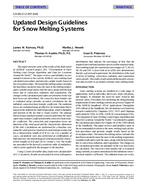Description
This paper presents some of the results of the final report of ASHRAE research project 926, “Development of Snow Melting Load Design Algorithms and Data for Locations Around the World.” The paper reviews and identifies recommended revisions to the current ASHRAE snow melting load calculation procedures and presents sample results based on the revised procedure. The load at the melting surface includes the heat fluxes needed to raise the snow to the melting temperature (sensible load) and to melt the snow, along with the heat losses due to convection, radiation, and evaporation. The changes in the calculation procedure are primarily in the way heat losses are determined. The convective heat transfer rate is evaluated using currently accepted correlations for the turbulent convection heat transfer coefficient. The radiation losses are evaluated using an effective sky temperature that is based on the ambient dry-bulb temperature, relative humidity, and fraction of the sky that is cloud covered. The analogy between mass and heat transfer is used to determine the water vapor mass transfer coefficient from the convective heat transfer coefficient. The convection and evaporation losses are functions of the wind speed and the characteristic dimension of the slab. Calculations are performed for a baseline case using the wind speed as reported on meteorological data and for a characteristic length of 20 ft (6.1 m). For a number of cases, calculations were also performed at combinations of half and twice the meteorological wind speed and for characteristic lengths of 20 ft and 5 ft (6.1 m and 1.5 m). The results are presented in the form of a sensitivity table of multipliers, which can be applied by the designer to the baseline. Using 12 years of weather data, loads were calculated for 46 U.S. locations. Results are presented in terms of frequency distributions that indicate the percentage of time that the required snow melting load does not exceed the reported value. Snow melting loads are reported for percentages of 75, 90, 95, 98, 99, and 100. A closer look at six of the sites demonstrates that for a given load requirement, the distribution of the load in terms of melting, convection, radiation, and evaporation varies greatly. The results clearly point out the need for concurrent data in order to accurately estimate snow melting loads.
Units: Dual
Citation: Symposium, ASHRAE Transactions, vol. 105, pt. 1
Product Details
- Published:
- 1999
- Number of Pages:
- 11
- File Size:
- 1 file , 180 KB
- Product Code(s):
- D-7619




